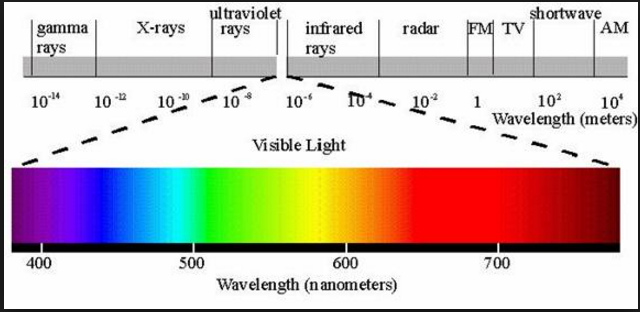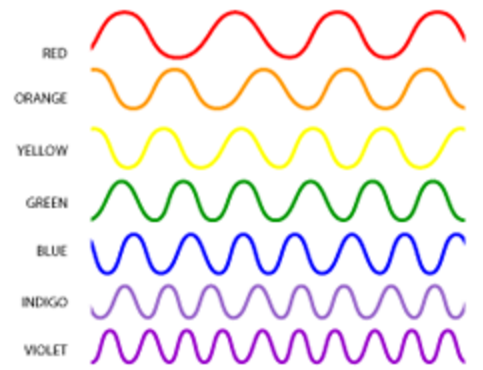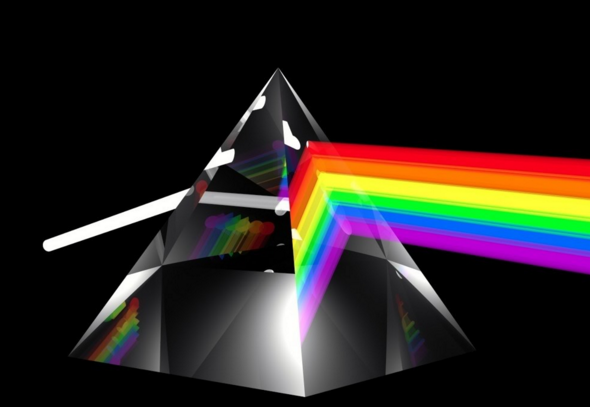Light Scattering: Why is the Sky Blue: Difference between revisions
No edit summary |
|||
| Line 38: | Line 38: | ||
Since there is no air in the atmosphere no light wavelength is difracted so it appears to be black. | Since there is no air in the atmosphere no light wavelength is difracted so it appears to be black. | ||
[[ | [[File:Space.PNG]] | ||
=History= | =History= | ||
Revision as of 23:49, 30 November 2015
by Irene Hammel
Visible Light Spectrum
Electromagnetic Radiation is light, but only a small part is visible to the human eye. This portion is known as the visible light spectrum, the rest os the spectrum is either too large or too small for our eyes to receive. Visible light falls between infrared (IR) and ultraviolet (UV). It has wavelengths of about 740 nanometers (nm) to 380 nm. The image belows shows how small the portion of visible light is in comparison to all the wavelengths that exist. The most important characcteristic of visible light is color. Our eyes percieve each wavelength as a different color. The following section will go more in detail of how wavelengths relate to colors and how humans perceive them.
Wavelengths
The wavelengths of reflected light determine what color you see. Light at the lower end of the visible spectrum is perceived as red. Green light is found in the middle of the spectrum. While light at the upper end of the spectrum is seen as violet. All other colors that we perceive are mixtures of these colors. White light contains all colors and black is the absence of light. Our eyes are able to percieve these colors because of cones our eyes contains. Cones are photoreceptors, in other words tiny cells in the retina that respond to light. There are around 6 to 7 million cones in the light-sensitive retina at the back of your eye. In the image below you can see which wavelength represents each colors and also the relation of color and amplitude.
Prism
A prism is is a transparent optical element with flat, polished surfaces that refracts light, its traditional shape is a triangle either way a prism will have two surfaces with an angle between them. A prism breaks a white light into its individual colors, with their unique wavelengths. This type of prism was created by Isaac Newton.
Lightscatering
Light scattering can be thought of as the deflection from a straight path of a ray of light. Objects are visible because of the light scattering from their surfaces. Scattering of light depends on the wavelength and/or frequency of the light.
Rayleigh Scattering
Rayleigh scattering is the scattering of light by molecules that are much smaller than the wavelength of the light. It occurs when light penetrates any of the three main phases of matter, gas, liquid, and solid. Rayleigh scattering intensity depends strongly on the size of the particles. This kind of scattering can be considered to be elastic scattering because the photon energies of the scattered photons do not change.
Why is the Sky Blue?
The sky is blue because of the light scattering phenomenon. The rays of light from the sun travel through the atmosphere which contains air particles. The sun rays appear white because they contain all the colors and wavelengths. When the light goes through the air it hits the light molecules and bounces off into different directions. Due to Rayleigh scattering blue is more scattered because it has a shorter wavelength and Rayleigh scattering states that shorter wavelengths scatter more strongly. This scattered light that gives the surrounding sky its brightness and its color. Longer wavelengths pass through and are not difracted which is why they do not affect the color of the sky.
Why is the Sunset Red?
As the sun begins to set, the rays of sun must travel further through the atmosphere before it gets to you. The longer it takes the more wavelengths are already scattered, so the color of the sun itself appears to change, first to orange and then to red. Since blues and greens have shorter waveengths by the time they reach you hey are already scattered. Only the longer wavelengths are left which is why you are able to see a red sunset.
Why is the Universe Black
Since there is no air in the atmosphere no light wavelength is difracted so it appears to be black.
History
Isaac Newton (1643-1727) was born in England. Although studied law, he was an established physicist and mathematician, and is credited as one of the great minds of the 17th century Scientific Revolution. Between his biggest discoveries, are the theory of gravity, the three laws of motion, calculus and the refraction of light.
John William Strutt (Lord Rayleigh) (1842-1919) was born in the United Kingdom. He made fundamental discoveries in the fields of acoustics and optics that are basic to the theory of wave propagation in fluids.
See also
Further reading
Read more about:
- Lord Rayleigh (John Strutt): http://micro.magnet.fsu.edu/optics/timeline/people/rayleigh.html
- Isaac Newton: http://www.biography.com/people/isaac-newton-9422656
- Electromagnetic and Visible Spectra: http://www.physicsclassroom.com/class/light/Lesson-2/The-Electromagnetic-and-Visible-Spectra
- Dispersion of Light by Prisms: http://www.physicsclassroom.com/class/refrn/Lesson-4/Dispersion-of-Light-by-Prisms
External links
http://science.hq.nasa.gov/kids/imagers/ems/visible.html
http://www.sciencekids.co.nz/sciencefacts/light.html
References
http://www.sciencemadesimple.com/space_black_sunset_red.html
http://missionscience.nasa.gov/ems/09_visiblelight.html
http://www.livescience.com/50678-visible-light.html
http://www.livescience.com/32559-why-do-we-see-in-color.html
http://www.webexhibits.org/colorart/bh.html
http://www.edmundoptics.com/technical-resources-center/optics/introduction-to-optical-prisms/
http://www.britannica.com/biography/John-William-Strutt-3rd-Baron-Rayleigh







